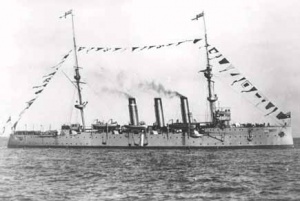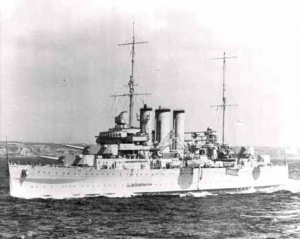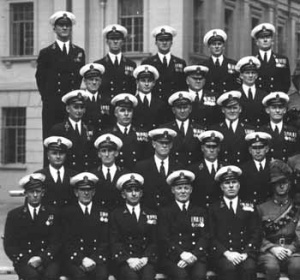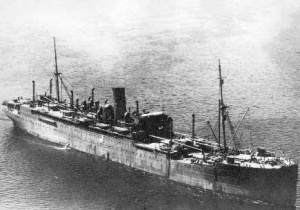Lieutenant William Evan Crawford Allan
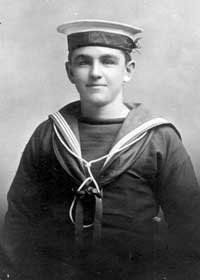
William Evan Crawford Allan (1899–2005), ‘Darby’ to his shipmates, was born on 24 July 1899 at Bega in New South Wales. His grandfather was one of the original settlers in the Bega region and as a child, Evan was brought up on a family property in nearby Upper Brogo. Interviewed in 2000, he highlighted the 1908 visit of the American Great White Fleet as influencing his desire to join the Royal Australian Navy (RAN). This ambition was realised on 13 March 1914, when he enlisted as a 14-year old boy second class and began his naval career in the boys training ship HMAS Tingira.
In July 1915, he joined the light cruiser HMAS Encounter, which shortly thereafter sailed on a four-month patrol in the south-west Pacific area, using Fiji as a base for operations. Encounter also protected Fanning Island (Tabuaeran, Kirabati), to deter enemy forces from attempting to repeat the success of the German Navy's SMS Nürnberg, which, in a raid in September 1914, had destroyed the island's cable station and severed the Pacific communications cable. He then saw further active service overseas: in the Malay archipelago from late 1915 to early 1916; in the south-west Pacific between September and December 1917, when Encounter joined the search for the German raider Wolf; and on two voyages to Colombo on convoy escort duty.
He left Encounter in August 1918 for passage to the United Kingdom in the transport Barambah. During the voyage, there was an outbreak of influenza, which caused a significant number of deaths. Although he showed symptoms of infection, he was fortunate not to suffer the full and deadly effects of the disease. He then joined the cruiser HMAS Sydney in Scotland, one week after the surrender of the German High Seas Fleet. Sydney returned to Australia in July 1919 after a long passage from England via the Suez Canal.
He was then drafted to HMAS Brisbane in September 1919, and served in the cruiser for the following three years. The period was typical of peacetime service. The only overseas port visits were to Penang and Singapore in March 1921 and New Guinea in September 1921. It was a significant time in the context of his professional development. He was promoted to leading seaman in November 1919 and then to petty officer in June 1922; he qualified as a seaman torpedoman; and he volunteered to join the fledgling submarine service in September 1921. He also ran a popular side business developing photographs, taken with his own camera, and printing them onto postcards for sale to his shipmates.
Brisbane was decommissioned on 4 August 1922 and the crew commissioned the light cruiser HMAS Adelaide the following day. It transpired that he would spend almost four years in Adelaide. The undoubted highlight was the ship's attachment to the Royal Navy’s Special Service Squadron in 1924. Adelaide sailed from Sydney in April 1924 and accompanied the squadron on the second half of its world cruise. The squadron arrived in Portsmouth in late September 1924, having visited Canada, Fiji, Hawaii, Jamaica, New Zealand, Panama and the United States. Adelaide became the first RAN ship to pass through the Panama Canal. The ship sailed from England in January 1925 and arrived in Australia three months later.
He returned to Tingira in June 1926, taking on instructional duties until the boys training ship was decommissioned in June 1927. A short stint in the depot and accommodation ship HMAS Penguin (ex Encounter) preceded service in HMAS Melbourne, which sailed from Sydney in February 1928 on its decommissioning cruise to England. Melbourne decommissioned at Portsmouth on 23 April 1928 and its crew transferred to the newly built heavy cruiser HMAS Australia, which was commissioned the next day. Following sea trials, Australia departed Portsmouth in August 1928 for its delivery voyage to Australia, visiting Canada, the United States, Jamaica, Panama, Tahiti and New Zealand.
On 6 August 1928, Australia was in the North Atlantic en route to Montreal when William Allan was swept overboard with heavy seas running in fresh gale-force winds (62–74 kilometres per hour). Allan and several other crew members had been attempting to recover the starboard breakwater door, which was adrift on the forecastle. The official report states that a large sea came inboard and swept the fore part of the forecastle. When it cleared, the Commanding Officer saw Allan swimming in the water abreast of the bridge. The state of the sea precluded the safe launching of the sea boat, and it was only due to Allan’s remarkable coolness and the prompt actions of Commissioned Shipwright William White, Lieutenant Commander Rupert Long, and Allan’s divisional officer, Lieutenant Commander Harry Howden, that tragedy was averted. Allan suffered from shock caused by immersion and contusions to one leg, the latter the result of the heavy seas bumping his body against the cruiser's hull when he was hauled back on board.
He seems to have given some thought to parting from the Permanent Navy in early 1929 and transferring to the RAN Auxiliary Services – his engagement was due to expire in July 1929. In January 1929, Captain John Stevenson, then second naval member of the Australian Commonwealth Naval Board, observed that a decision to leave would be a decided loss to the service. Captain Stevenson had been Allan’s commanding officer in Encounter, Brisbane and Adelaide, and had a high regard for Allan’s abilities as a professional sailor; Stevenson made a point of highlighting Allan’s very good conduct and superior abilities.
In mid-1929, Allan was drafted to Sydney to join HMAS Penguin. Penguin was formerly the submarine depot ship HMAS Platypus and had been re-assigned for service as a depot and accommodation ship. Promoted to chief petty officer in April 1932, he remained in Penguin throughout the early years of the Great Depression until January 1933, when he served briefly in the seaplane carrier HMAS Albatross.
In 1933, he proceeded to England in the SS Comorin to commission the Scott-class flotilla leader HMAS Stuart. Stuart had been in commission with the Royal Navy since 1918 and, in 1933, the Admiralty agreed to loan Stuart and four V- and W-class destroyers (HMA Ships Vampire, Vendetta, Voyager and Waterhen) to the Royal Australian Navy. The five ships were commissioned at Portsmouth on 11 October 1933 to form the Australian destroyer flotilla, later to become famous in the Second World War as the ‘Scrap Iron Flotilla’.
He left Stuart to join the heavy cruiser HMAS Canberra in July 1934. His service in Canberra was generally routine peacetime cruising in home waters. One of the few highlights came in late 1934, when Canberra was tasked on Royal Escort duty when His Royal Highness The Duke of Gloucester visited Australia in HMS Sussex.
Allan took the opportunity to further his professional knowledge of small craft operations by studying for a Master's Ticket in Sydney. The Maritime Services Board of New South Wales issued him a Certificate of Competency as Master of a Harbour and River Steamer on 14 July 1936. The qualification was a necessary prerequisite for him to apply for the position of master of the 120-foot auxiliary vessel Ripple, which was expected to become vacant the following year. Ripple was employed by the RAN as a water tender. The support of Commander Harry Howden, one of his rescuers from 1928, is further evidence of the rapport that he had with senior naval officers.
In late 1936, Allan volunteered to join the naval detachment of the Australian Coronation Contingent, which would travel to England to represent Australia at the coronation of King George VI on 12 May 1937. There were 25 members of the naval detachment, led by a commissioned warrant officer; 14 of these were permanent service ratings and the remaining 10 drawn from the Royal Australian Fleet Reserve, Royal Australian Naval Reserve and RAN Auxiliary Services. They embarked in the SS Oronsay in February 1937. Apart from their royal ceremonial duties, the contingent attended a number of official functions in England and Scotland. Their final engagements were in France, and the contingent embarked in the RMS Orama at Toulon for passage to Sydney.
In August 1937, Allan began duty at the Royal Australian Naval College, at Flinders Naval Depot in Victoria, instructing the young cadet midshipmen in the art of sailing and seamanship. In early 1938, the college underwent an organisational change from the ‘year’ system to the ‘house’ system, and he assumed the mantle of the ‘Flinders House’ chief petty officer.
He was drafted for active service in the armed merchant cruiser HMS Moreton Bay one month after the outbreak of the Second World War. Built as a passenger and cargo liner, Moreton Bay was fitted out in Sydney and served on the China Station, the East Indies Station and then in the South Atlantic on patrol and convoy escort duties. When Moreton Bay decommissioned in August 1941 for conversion to a troopship, arrangements were made to return its Australian crew via the United States and Canada, arriving in Sydney on 5 December 1941.
While serving in Moreton Bay, Allan's commanding officer had recommended him for promotion to warrant rank (in this case, boatswain). He was duly promoted to acting boatswain, effective 9 July 1942, and appointed to the instructional staff at the new Officers’ Training School, under the charge of Commander Alan Harris RN. Commander Harris described Allan as ‘a man of outstanding qualities’ and ‘an excellent influence on the young men in his charge’. The Officers’ Training School had been established because of the urgent requirement to provide properly trained officers to crew a rapidly expanding wartime fleet.
In July 1944, Allan was posted to HMAS Ladava, the RAN depot at Milne Bay in New Guinea, for service as the piermaster. Although this was a short appointment, of only six months' duration, the commanding officer of Ladava observed that Allan’s common sense and service knowledge ‘helped guide the many inexperienced officers’ and that ‘he has created order out of confusion that existed amongst the boats and lighters’. Not surprisingly, he was recommended for promotion to commissioned rank.
From Ladava, he was appointed again to the cruiser Australia as the ship’s boatswain, replacing Boatswain Cyril Deighton, who had been injured in the Japanese kamikaze attacks at Leyte Gulf in October. Allan was flown to Seeadler Harbour but missed his connection with Australia by a matter of hours, the ship having already sailed for operations at Lingayen Gulf. In a twist of fate, Sub Lieutenant Keith Levy, who was tasked with discharging the duties of boatswain during Allan's absence, was killed in action when Australia was hit by another kamikaze on 5 January 1945.
Allan eventually joined Australia when the ship returned to Seeadler Harbour in late January 1945. The ship had sustained considerable battle damage at Lingayen Gulf and proceeded direct to Sydney for repair. He left the ship in May 1945 to assume duty as the instructional boatswain at the New Entry School at Cerberus. Promoted to Acting Commissioned Boatswain in January 1946, Evan saw out the remainder of his naval career instructing at Cerberus. He was highly regarded by his superiors and commanded the respect of his subordinates; Commodore Henry Showers RAN, then commodore superintendent of training, was strong in his recommendation that Allan's services be retained, despite the postwar personnel reductions.
Allan retired from the Navy on 30 October 1947. He lived on a small farm in the Frankston area, not far from Cerberus, to raise his young family. Although he shied away from events such as Anzac Day marches, he maintained a keen interest in contemporary naval affairs. He served the nation as a professional sailor for over 33 years, throughout both world wars. He commissioned four ships, decommissioned a further three and was the recipient of both the 1935 King's Silver Jubilee Medal and the 1937 Coronation Medal. In the postwar years, the RAN adopted Royal Navy provisions governing the institution of a war service rank and, in 1948, the Naval Board wrote to Allan confirming that he had been granted the war service rank of lieutenant. He was much later presented with the 80th Anniversary Armistice Remembrance Medal (1999) and the Centenary Medal (2001).
William Evan Allan passed away on 17 October 2005 at the age of 106. He was Australia's last surviving First World War veteran, and the last remaining Australian veteran to have seen active service in both world wars. He was farewelled with a state funeral at St Mark's Chapel, HMAS Cerberus, on 25 October 2005. His ashes were scattered in Port Phillip Bay from the flight deck of HMAS Sydney on 24 July 2006.

